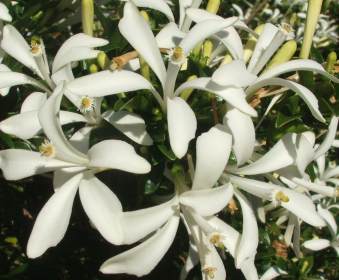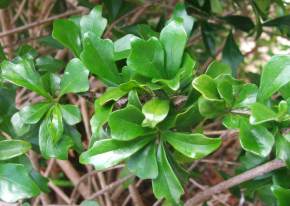Turraea obtusifolia
Turraea obtusifolia Hochst.
Family: Meliaceae
Common names: small honeysuckle tree, lesser honeysuckle tree, (Eng.); kleinkamperfoelieboom (Afr.); amazulu, ikhambi-lomsinga [roots], ikunzi [roots], ikunzi ebomvana, inkunzi, umhlatholana, umhlatolana, uswazi [leaves and stems] (Zulu)
SA Tree No: 296.1
Introduction
Turraea obtusifolia is an ornamental shrub with glossy dark green foliage, masses of showy white flowers in summer and decorative orange-red fruits in late summer to winter.

Description
Description
A semi-evergreen shrub or small tree, 1-3 x 1 m. In open sunny places it is a bushy shrub but in shade or semi-shade it becomes more of a scrambler or small tree. The leaves are a dark glossy green, clustered on short side shoots, variable in size and shape on a single plant, from narrowly oblanceolate (lance-shaped with the widest part above the middle) to obovate (egg-shaped with the widest part above the middle) and sometimes with two lobes towards the tip.

The flowers are large ( ± 35 mm in diameter), showy, pure white and produced abundantly in small clusters amongst the leaves during mid- to late summer (Jan.-Feb.). Each flower has 5 free petals, and 10 stamens fused to form a narrow cylindrical tube (35 mm long) ending in 20 irregularly lobed, long and narrow appendages and a short frill that carries the anthers. The style is longer than the staminal tube and ends in a top-shaped or cylindrical pollen presenter. Only the tip of the style is receptive to pollen.

The flowers are completely unscented during the day, slightly fragrant at night, and are pollinated by moths. Before a flower opens, it deposits its pollen on the sides of the pollen presenter. The flowers remain open for more than one night and the pollen is transferred to other flowers by visiting moths Because only the very tip of the style is receptive to pollen, self-pollination is avoided.
The fruit is a segmented green capsule, ± 6 x 13 mm, like a miniature pumpkin, splitting and peeling back to reveal shiny orange-red, kidney-shaped seeds (Feb.-June). In other turraeas, such as T. floribunda, the seeds have bright orange arils that attract birds who eat and disperse the seeds. The orange-red part in Turraea obtusifolia is not an aril but the seed coat. There is an aril but it is white, very small and completely hidden. All parts of this plant are poisonous.

Conservation Status
Status
Turraea obtusifolia is not listed on the Red List of South African plants 2006-08-07.
Distribution and habitat
Distribution description
Turraea obtusifolia is found in coastal forest, bushveld, coastal dunes and rocky outcrops on the east coast in the Eastern Cape, KwaZulu-Natal and Mozambique and in Mpumalanga, Gauteng, Limpopo, North-West, Swaziland, Botswana and Zimbabwe.
Derivation of name and historical aspects
History
The genus Turraea is named after Georgio della Turre, professor of botany and director of the Botanic Garden at Padua from 1649-1683, who published a catalogue of the plants in the garden in 1660. The species name, obtusifolia, means blunt-leaved in Latin and refers to the often blunt tip of the leaves.
The common name, small honeysuckle tree, is derived from the superficial resemblance of the flowers of its sister species Turraea floribunda, the wild honeysuckle tree, to those of the honeysuckle, genus Lonicera, family Caprifoliaceae, but there is no real relationship between them. The flowers of T. floribunda have longer and narrower, greenish yellow petals and a strong, sweet scent, and the resemblance to honeysuckle is much stronger than in T. obtusifolia, whose starry white flowers are more often mistaken for a kind of jasmine. I frequently see visitors to Kirstenbosch spot a bush in flower and go over to smell the flowers, expecting to be rewarded with a sweet jasmine-like fragrance but being rebuffed, finding absolutely no scent whatsoever.
There are ± 50 species of Turraea occurring in Africa, Madagascar, the Mascarenes and the Comores and one that occurs in the tropical Far East. Six species occur in southern Africa: T. obtusifolia and T. floribunda (wild honeysuckle tree) occur in the Eastern Cape, KwaZulu-Natal and Swaziland ; T. nilotica (Lowveld honeysuckle tree) in Limpopo, Mpumalanga, and Swaziland ; T. pulchella (dwarf honeysuckle tree) in Eastern Cape and KwaZulu-Natal ; T. streyi in KwaZulu-Natal ; and T. zambesica (Zambezi turraea) in Botswana and Namibia.
The mahogany family (Meliaceae) is a large, tropical and subtropical family famous for its timber trees. It is made up of ± 50 genera and 800 species. In southern Africa there are six indigenous genera: Nymania, Ekebergia, Entandophragma, Pseudobersama, Trichilia and Turraea and four introduced and now naturalized genera: Cedrela, Khaya, Melia and Toona. Most South Africans would recognize Melia azedarach, known as the syringa or Persian lilac, a decorative garden tree introduced from India that has naturalized in many parts of the country and is now a declared invasive. Other members of the Meliaceae featured on plantzafrica.com to date include Nymania capensis, Ekebergia capensis, E. pterophylla, and Trichilia dregeana.
Ecology
Ecology
The flowers are pollinated by moths. Before a flower opens, it deposits its pollen on the sides of the style head. Flowers remain open for more than one night. The pollen is transferred to other flowers by visiting moths Only the very tip of the style is receptive to pollen, so self-pollination is avoided.

Uses
Use
Turraea obtusifolia is said to be very poisonous. Its leaves, bark and rootbark are used in traditional medicine to treat stomach and intestinal ailments, and as a drastic purge. The leaves contain chemical compounds known as limonoids, like those found in the neem tree ( Azadirachta indica also in the Meliaceae, native to India ) which are used in agriculture as antifeedants i.e. as insect repellants to protect crop plants from insect damage. Turraea obtusifolia could therefore also be used as an antifeedant.
The related species, T. floribunda, is also used in traditional medicine to prevent fearful dreams associated with a weak heart, as a strengthening tonic after the death of a kraal member, to induce the neurotic state needed by diviners for divining dances, and to treat heart disease, rheumatism and swollen, painful joints, and in Zimbabwe, T. nilotica roots are used to treat abdominal pain, venereal diseases, constipation, menstrual cramps, epilepsy, diarrhoea and pneumonia.
Growing Turraea obtusifolia
Grow
Turraea obtusifolia will perform at its best if grown in well-drained but moist, nutrient-rich, loamy, humus-rich soil in a warm, sunny, semi-shaded or lightly shaded position. It needs water in summer but will tolerate drought during winter. It is sensitive to strong winds and frost. It is quite quick to get going from seed but is slow-growing and long-lived. Prune to shape. Use it as an ornamental shrub in the garden or a specimen in a container.
Propagate by seed or cuttings. Sow fresh seed soon after harvesting in autumn-winter, or keep the seed cool and dry (not frozen) and sow in spring. Clean off the fleshy orange layer and sow 2 mm deep in well-drained, sterile soil, and place the trays over bottom heat of 28°C. Take softwood or herbaceous cuttings of the new growth that is hardening, in spring to summer. Use a rooting hormone and place the cuttings in a mist unit with bottom heat of 28° C.
References
- Hutchings, A. 1996. Zulu medicinal plants: an inventory. University of Natal Press, Pietermaritzburg.
- Leistner, O.A. (ed.). 2000. Seed plants of southern Africa : families and genera. Strelitzia 10. National Botanical Institute, Pretoria.
- Palmer, E. & Pitman, N. 1972. Trees of southern Africa. Balkema, Cape Town.
- Plants of southern Africa : an online checklist. http://posa.sanbi.org.
- Red List of South African plants. 2006-08-07. www.sanbi.org/biodiversity/reddata.htm.
- Van Wyk, B-E. & Gericke, N. 2000. People's plants. Briza Publications, Pretoria.
- White, F. 1988. Turraea obtusifolia (Meliaceae). The Flowering Plants of Africa 50: t. 1962.
Credits
Alice Notten
Kirstenbosch National Botanical Garden
February 2007
Plant Attributes:
Plant Type: Shrub
SA Distribution: Eastern Cape, Gauteng, KwaZulu-Natal, Limpopo, Mpumalanga, North West
Soil type: Loam
Flowering season: Late Summer
PH: Acid, Neutral
Flower colour: White
Aspect: Full Sun, Morning Sun (Semi Shade), Afternoon Sun (Semi Shade)
Gardening skill: Easy
Special Features:
Horticultural zones










Rate this article
Article well written and informative
Rate this plant
Is this an interesting plant?
Login to add your Comment
Back to topNot registered yet? Click here to register.